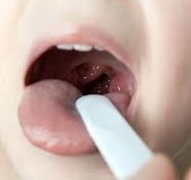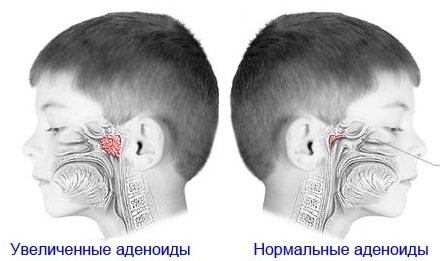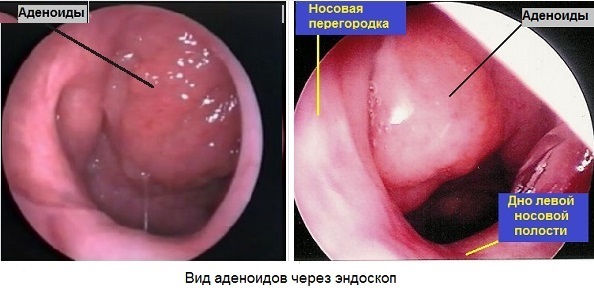 Adenoids are found mainly in children from 3 to 12 years of age and they bring a lot of discomfort and trouble to the babies and their parents, so they require urgent treatment. Often the course of the disease is complicated, after which there is adenoiditis - inflammation of the adenoids.
Adenoids are found mainly in children from 3 to 12 years of age and they bring a lot of discomfort and trouble to the babies and their parents, so they require urgent treatment. Often the course of the disease is complicated, after which there is adenoiditis - inflammation of the adenoids.
Adenoids in children can occur in early preschool years and persist for several years. In secondary school, they usually decrease in size and gradually atrophy.
Adults do not occur in adults: the symptoms of the disease are characteristic only of childhood. Even if in childhood you had this disease, in adulthood it does not return.
Reasons for developing adenoids in children
What is it? Adenoids in the nose in children - this is nothing like the proliferation of pharyngeal tonsil tissue. This anatomical formation, which is normally part of the immune system. Nasopharyngeal tonsil, holds the first line of defense against various microorganisms seeking to enter the body with inhaled air.
In case of disease, the tonsil increases, and when the inflammation passes, it returns to normal. In the case when the time between diseases is too small( say, a week or even less), the sprouting does not have time to decrease. Thus, being in a state of constant inflammation, they grow even more and sometimes "swell" to such an extent that they cover the entire nasopharynx.
Pathology is most typical for children aged 3 to 7 years. Rarely diagnosed in children under one year. The proliferating adenoid tissue often undergoes reverse development, so adolescence and adulthood practically do not occur in adolescence and adulthood. Despite such a feature, it is impossible to ignore the problem, since the enlarged and inflamed tonsil is a constant source of infection.
The development of adenoids in children is promoted by frequent acute and chronic diseases of the upper respiratory tract: pharyngitis, tonsillitis, laryngitis. The starting factor for the growth of adenoids in children can be infections - influenza, ARVI, measles, diphtheria, scarlet fever, whooping cough, rubella, etc. A certain role in the growth of adenoids in children can play syphilitic infection( congenital syphilis), tuberculosis. Adenoids in children can occur as an isolated pathology of lymphoid tissue, but they are much more often combined with sore throats.
Among other reasons, leading to adenoids in children, are an increased allergization of the child's body, hypovitaminosis, nutritional factors, fungal infestations, adverse social conditions, etc.

Symptoms of adenoids in the nose in a child
In a normal state, adenoids in children of symptoms, interfere with ordinary life, do not have - the child simply does not notice them. But as a result of frequent catarrhal and viral diseases adenoids, as a rule, increase. This is because adenoids are strengthened by the growth to fulfill their immediate function of retaining and destroying microbes and viruses. Inflammation of the tonsils - this is the process of eliminating pathogens, which is the cause of the increase in glands in size.
The main signs of adenoids include the following:
- is a frequent, long runny nose that is difficult to treat;
- obstructed nasal breathing even in the absence of rhinitis;
- persistent mucosal discharge from the nose, which lead to irritation of the skin around the nose and on the upper lip;
- inhalation with open mouth, lower jaw then hanging, nasolabial folds flatten, face becomes indifferent expression;
- is a bad, restless sleep;
- snoring and sniffing in sleep, sometimes - holding the breath;
- sluggish, lethargic state, decreased academic performance, efficiency, attention and memory;
- attacks of nocturnal asphyxia, characteristic of adenoids of the second-third degree;
- permanent dry cough in the morning;
- involuntary movements: a nervous tic and blinking;
- voice loses sonority, becomes dull, with hoarseness; lethargy, apathy;
- complaints of a headache that arises from a lack of oxygen in the brain;
- hearing loss - the child often re-requests.
Modern otolaryngology divides the adenoids into three degrees:
- 1 degree of : adenoids in the child are small. In this day, the child breathes freely, difficulty breathing is felt at night, in a horizontal position. The child often sleeps, slightly opening his mouth.
- 2 degree : adenoids in the child are significantly increased. The child is forced to breathe through the mouth all the time, snoring loudly at night.
- 3 degree of : the adenoids in the child completely or almost completely block the nasopharynx. The child does not sleep well at night. Unable to restore his strength during sleep, during the day he easily tired, attention is dissipated. He has a headache. He is forced to constantly keep his mouth open, resulting in changes in facial features. The nasal cavity ceases to be ventilated, a chronic rhinitis develops. The voice becomes nasal, speech - indistinct.
Unfortunately, parents often pay attention to deviations in the development of adenoids only at stage 2-3, when the difficult or absent nasal breathing is pronounced.
Adenoids in children: photo
How adenoids look in children, we offer detailed photos for viewing.

Treatment of adenoids in children
In the case of adenoids in children, there are two types of treatment - surgical and conservative. Whenever this is possible, doctors tend to avoid surgery. But in some cases you can not do without it.
Conservative treatment of adenoids in children without surgery is the most correct, priority in the treatment of pharyngeal tonsillitis hypertrophy. Before agreeing to an operation, parents should use all available treatments to avoid adenotomy.
If ENT insists on surgical removal of adenoids - take your time, this is not an urgent operation, when there is no time for meditation and additional observation and diagnosis. Wait, follow the child, listen to the opinions of other specialists, make the diagnosis after a few months and try all the conservative ways.
If the drug treatment does not give the desired effect, and the child has a chronic chronic inflammatory process in the nasopharynx, then for the consultation it is necessary to contact the operating doctors, those who make the adenotomy.
Adenoids 3 degrees in children - to delete or not?
When choosing - adenotomy or conservative treatment can not be based solely on the degree of adenoids proliferation. At 1-2 degrees of adenoids, most believe that they do not need to be removed, but at grade 3, surgery is simply required. This is not entirely true, it all depends on the quality of the diagnosis, often there are cases of false diagnosis, when the examination is performed against the background of a disease or after a recent cold, the child is diagnosed with a grade 3 and advised to remove the adenoids promptly.
And a month later adenoids noticeably decrease in size, as they were increased due to the inflammatory process, with the child breathing normally and not too often sick. And there are cases, on the contrary, at 1-2 degrees of adenoids the child suffers from constant ORVI, relapsing otitis, in a dream occurs apnea syndrome - even 1-2 degree can be an indication to the removal of adenoids.
Also about the adenoids of the 3rd degree will tell the famous pediatrician Komarovsky:
Conservative therapy
Complex conservative therapy is used for moderate uncomplicated tonsillar enlargement and includes treatment with medications, physiotherapy and breathing exercises.
Usually the following drugs are prescribed:
- Antiallergic( antihistamines) - tavegil, suprastin. Used to reduce the manifestations of allergies, they eliminate swelling of the tissues of the nasopharynx, pain and the amount of detachable.
- Antiseptics for topical application - collargol, protargol. These drugs contain silver and destroy the pathogenic microflora.
- Homeopathy is the safest of known methods, well combined with traditional treatment( although the effectiveness of the method is very individual - someone helps well, someone is weak).
- Wash .The procedure removes pus from the surface of the adenoids. It is performed only by a doctor in the "cuckoo" manner( by injecting a solution into one nostril and sucking it from another vacuum) or by a nasopharyngeal shower. If you decide to do washing at home, pound the pus even deeper.
- Physiotherapy .Quartz movements of the nose and throat are effective, as well as laser therapy with the carrying of the light guide into the nasopharynx through the nose.
- Climatotherapy - treatment in specialized sanatoriums not only hinders the growth of lymphoid tissue, but also has a positive effect on the children's body as a whole.
- Multivitamins for strengthening immunity.
Physiotherapy procedures use heating, ultrasound, ultraviolet.

Removal of adenoids in children
Adenotomy is the removal of pharyngeal tonsils by surgical intervention. The treatment of the adenoids in children is best described by the attending physician. In a nutshell, the pharyngeal tonsil is captured and cut off with a special instrument. This is done in one motion and the whole operation takes no more than 15 minutes.
An undesirable way to treat a disease for two reasons:
- First, adenoids grow rapidly and, if there is a predisposition to this disease, they will become inflamed again and again, and any operation, even as simple as adenotomy, is a stress for children and parents.
- Secondly, pharyngeal tonsils perform a barrier-protective function, which as a result of removal of adenoids is lost to the body.
In addition, in order to conduct an adenotomy( i.e., removal of adenoids), it is necessary to have indications. These include:
- frequent occurrence of recurrence of the disease( more than four times a year);
- recognized ineffectiveness of conservative treatment;
- the appearance of respiratory arrest in sleep;
- appearance of various complications( arthritis, rheumatism, glomerulonephritis, vasculitis);
- nasal breathing disorder;
- very frequent repetitive otitis;
- very frequent recurring ARVI.
It should be understood that the operation is a kind of undermining of the immune system of a small patient. Therefore, a long time after the intervention it must be protected from inflammatory diseases. Postoperative period is necessarily accompanied by drug therapy - otherwise there is a risk of repeated proliferation of tissue.
Contraindications to adenotomy are certain blood diseases, as well as skin and infectious diseases in the acute period.

How to choose probiotics for the intestines: a list of drugs.

Effective and inexpensive cough syrups for children and adults.

Modern non-steroidal anti-inflammatory drugs.

Review of tablets from the increased pressure of the new generation.
 Antiviral drugs are inexpensive and effective.
Antiviral drugs are inexpensive and effective.



